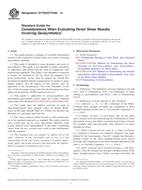Potřebujeme váš souhlas k využití jednotlivých dat, aby se vám mimo jiné mohly ukazovat informace týkající se vašich zájmů. Souhlas udělíte kliknutím na tlačítko „OK“.
ASTM D7702/D7702M-14
Standard Guide for Considerations When Evaluating Direct Shear Results Involving Geosynthetics
Automaticky přeložený název:
Standardní příručka pro úvahy při hodnocení Direct smyku výsledků týkajících se geosyntetiky
NORMA vydána dne 1.5.2014
Informace o normě:
Označení normy: ASTM D7702/D7702M-14
Poznámka: NEPLATNÁ
Datum vydání normy: 1.5.2014
Kód zboží: NS-38980
Počet stran: 11
Přibližná hmotnost: 33 g (0.07 liber)
Země: Americká technická norma
Kategorie: Technické normy ASTM
Kategorie - podobné normy:
Anotace textu normy ASTM D7702/D7702M-14 :
Keywords:
direct shear, GCL, interface shear strength, internal shear stress, Mohr-Coulomb friction angle, Mohr-Coulomb shear strength envelope, performance test, secant friction angle, ICS Number Code 59.080.70 (Geotextiles)
Doplňující informace
| Significance and Use | ||||||||
|
4.1 The shear strength of soil-geosynthetic interfaces and geosynthetic-geosynthetic interfaces is a critical design parameter for many civil engineering projects, including, but not limited to waste containment systems, mining applications, dam designs involving geosynthetics, mechanically stabilized earth structures, and reinforced soil slopes, and liquid impoundments. Since geosynthetic interfaces often serve as a weak plane on which sliding may occur, shear strengths of these interfaces are needed to assess the stability of earth materials resting on these interfaces, such as a waste mass or ore body over a lining system or the ability of a final cover to remain on a slope. Accordingly, project-specific shear testing using representative materials under conditions similar to those expected in the field is recommended for final design. Shear strengths of geosynthetic interfaces are obtained by either Test Method D5321/D5321M (geosynthetics) or D6243/D6243M (geosynthetic clay liners). This guide touches upon some of the issues that should be considered when evaluating shear strength data. Because of the large number of potential conditions that could exist, there may be other conditions not identified in this guide that could affect interpretation of the results. The seemingly infinite combinations of soils, geosynthetics, hydration, and wetting conditions, normal load distributions, strain rates, creep, pore pressures, etc., will always require individual engineering evaluations by qualified practitioners. Along the same lines, the list of references provided in this guide is not exhaustive, nor are the findings and suggestions of any particular reference meant to be considered conclusive. The references and their related findings are presented herein only as examples available in the literature of the types of considerations that others have found useful when evaluating direct shear test results. 4.2 The figures included in this guide are only examples intended to demonstrate selected concepts related to direct shear testing of geosynthetics. The values shown in the figures may not be representative and should not be used for design purposes. Site specific and material-specific tests should always be performed. |
||||||||
| 1. Scope | ||||||||
|
1.1 This guide presents a summary of available information related to the evaluation of direct shear test results involving geosynthetic materials. 1.2 This guide is intended to assist designers and users of geosynthetics. This guide is not intended to replace education or experience and should only be used in conjunction with professional judgment. This guide is not intended to represent or replace the standard of care by which the adequacy of a given professional service must be judged, nor should this document be applied without consideration of a project’s many unique aspects. Not all aspects of this practice may be applicable in all circumstances. The word “Standard” in the title of this document means only that the document has been approved through the ASTM consensus process. 1.3 This guide is applicable to soil-geosynthetic and geosynthetic-geosynthetic direct shear test results, obtained using either Test Method D5321/D5321M or D6243/D6243M. 1.4 This guide does not address selection of peak or large-displacement shear strength values for design. References on this topic include Thiel (1)2, Gilbert (1.5 The values stated in either SI units or inch-pound units are to be regarded separately as standard. The values stated in each system may not be exact equivalents; therefore, each system shall be used independently of the other. Combining values from the two systems may result in non-conformance with the standard. 1.6 This standard does not purport to address all of the safety concerns, if any, associated with its use. It is the responsibility of the user of this standard to establish appropriate safety and health practices and determine the applicability of regulatory limitations prior to use. |
||||||||
| 2. Referenced Documents | ||||||||
|




 Cookies
Cookies
